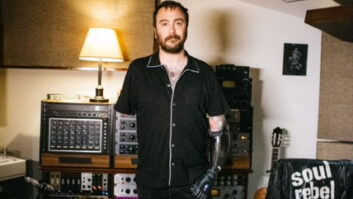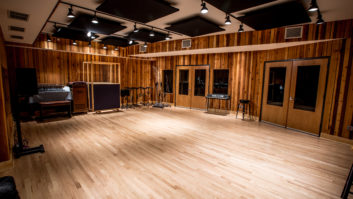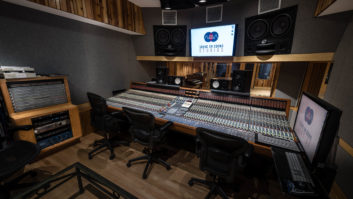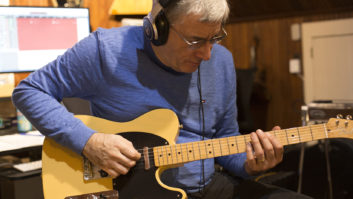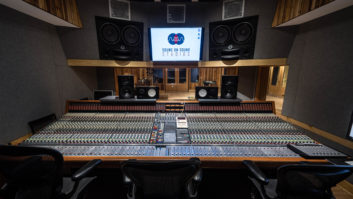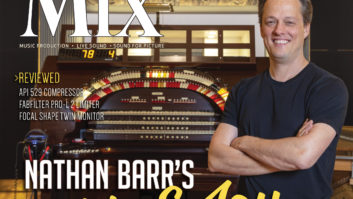There’s been a lot of anxiety lately over major studios closing. New York, Los Angeles, Nashville — each have their stories, from rental prices in New York to oversaturation in Nashville to producer-owned facilities opening in every canyon or beachfront property in L.A.
But before we lament the “death of the big room,” let’s not forget that these things move in cycles: In the ’70s, studios were rolling in the bookings, lockouts were common, bands stayed for months and budgets were huge. Then in the early ’80s, with the advent of MIDI, the first predictions of the death of the recording industry came along, and facility owners like Dave Porter of San Francisco’s Music Annex shouted “diversify or die.” Studios bounced back, and then in the early ’90s, with the advent of affordable digital multitracks and the rise of the project studio, the death knell was sounded once more.
Today, the worries are mounting again, as high-profile rooms have closed in Los Angeles and New York, with others rumored to be on the block. At the same time, new rooms are opening up and there’s more audio being produced than ever before — for ringtones, for games, for high-res 5.1 re-issues. People continue to make music, just not in the same way they have for the past 35 years. Big studios remain, and they always will. But the survivors have to be smart, nimble and business savvy.
SERVICE DIVERSITY
One strategy for success? Offer more under one roof. Increasingly, tough market conditions for two of New York City’s largest recording facilities, Right Track and Sound on Sound, led those facilities’ respective owners, Simon Andrews and Dave Amlen, to take the extremely unusual step of merging. The resultant entity, Right Track/Sound on Sound (RT/SOS, www.rttrk.com), was formed in November 2005, and sees both companies combining operations at Right Track’s 48th Street studios and massive, 4,600-square-foot orchestral live room on 38th Street.
“The change in the recording industry that led us to this merger is a decrease in the amount of work for the New York City recording community,” Chris Bubacz, general manager of RT/SOS, states candidly. “The record labels, specifically, seem to be working on few artists and even fewer in New York City. With this particular merger, we eliminated one location, Sound on Sound, and in basic economics, you cut down on your overhead. We had to take into account that we’re going to come down on the number of rooms available, and we hope that we won’t have to turn away too much work having less rooms, but at Right Track, there’s a lot of raw space and so much potential here for growth. [Sound on Sound] had a very constricting lease and really not a lot of space to expand.”
NRG’s Jay Baumgardner brings his own clients into the studio.
As a result, the merged companies were able to retain all staff and can now book their studios — which include the SSL 9000 J — equipped Studio A, Euphonix System 5 all-digital Studio B, SSL 9000 — based Studio C, affordable D1 and D2 production rooms, and the above-mentioned orchestral Studio A509 — with a logically combined client base. “Over the years, Right Track had moved into more specific types of music,” Bubacz says. “They built the large scoring stage the likes of which there’s really no place on the East Coast that you can work at for Broadway show cast albums and film scoring, but their record album work had started to fizzle out a little bit. Sound on Sound didn’t have the capability of doing large Broadway shows or film scores, but we had expanded to do more and more music recording. Each studio owner looked at each other’s business, didn’t see an overlap, and said, ‘What a great idea. Put the two companies together under one roof and you should be able to maximize your booking potential.’” For now, the strategy appears to be working, with Bubacz reporting a strong first-quarter ’06.
Post facilities, which often interface daily with the ever-growing web of media production, are poised to broaden their services. “I would say I have evidence that entertainment producers are not necessarily spending less in total, but they are spending it for a wider range of distribution media,” points out Joe Caterini, executive VP, sales, of PostWorks (www.pwny.com), which provides comprehensive audio and video services, including surround and HD, from two large New York City — based facilities. “That makes it necessary for a facility to be diverse. The dollars might be there, but rather than putting all that money into recording and producing a record, clients might take that same amount of money and also put it into a DVD documentary to go along with that record or make a presentation for a Website.
“The result is that the entertainment industry needs to make such a wide range of things to hit their market,” he continues. “They can’t spend more, so they spread it out on smaller pieces. At PostWorks, that even extends to in-store entertainment. We create the final product that will go on a small display in a Walmart. So facilities should want to hit people from many different angles. If clients are going to select you as the contractor to do the work, you better be able to deliver every component they need or they’re going to be stuck shopping for 10 different people — or find one place that can do it all.”
OFF THE BEATEN PATH
Other facilities are looking to see how they can cover more ground by themselves. One such studio is the forward-thinking Crystalphonic (www.crystalphonic.com) in Charlottesville, Va., which has been constantly tweaking its business plan since owner Kevin McNoldy opened the doors in the summer of 2003.
“We are a multiroom, multifaceted facility that was built to cater to major record labels, but also to the artistry of Virginia and the surrounding regions,” McNoldy says. “My first version of the studio was everything I had always wanted in terms of the producer’s dream studio: the SSL console, all the outboard gear and large rooms. After that wore off, we turned the room into something that worked better for us sonically and in terms of workflow. We replaced the SSL with a Digidesign D-Control for a hybrid approach of digital and all the outboard we have.
Joe Caterini of PostWorks, a one-stop post facility in New York
“Because of where we’re located, outside of the industry norm, we’re able and willing to go out on a limb with equipment purchases and how we position ourselves. We looked at the market and obviously our clients, but then we looked at what’s going to drive us and get us excited about working there. There’s a build-it-and-they-will-come feel that L.A. and New York studios can’t pull off because they’ve got to stick to the paradigm.”
With one of the major cornerstones of Crystalphonic’s original strategy — locating in a talent-rich but underserved area — paying off, McNoldy recently decided to do it again with a remote mixing/mastering room in Orlando, Fla., an area he sees as brimming with undiscovered talent. He divides his time manning his facility and hitting the streets in search of more talent. “We have DigiDelivery set up from both locations, so if I’m mixing an artist [that tracked in Charlottesville], we can do it all with digital transfers over the Internet and can move more projects quickly. That way, I can log onto the computer and manage both places online, which is very exciting.”
Whether the location is Virginia or Florida, McNoldy is not one to view the constant proliferation of quality home/personal studios as a threat to his business. “I don’t believe it’s hurt our bottom line; I think it’s helped if anything,” he states. “People can get okay results on lower-cost equipment, but they still need the experience of an engineer to make it sound right. There’s a lot of bands that come in who can’t do things from start to finish, and there’s no reason we can’t have a symbiotic relationship.
“It sucks if someone stays at home and does the whole thing, but we can get in on the food chain by recording drums, overdubs, et cetera. I’m promoting that we’re the ones who can help them out; we’re very proactive about reaching out to bands who are home recording. When people hear the actual vintage gear in process on their own projects as opposed to a virtual plug-in, they get hooked for life.”
MASTERING OPTIONS
In the mastering sector, however, facility owners like Randy LeRoy of Nashville’s Final Stage Mastering (www.finalstage.com) are watching the progress of personal studios with keen interest and developing their own counter-strategies. “I wouldn’t say mastering is exempt from the advent of personal studios,” LeRoy says. “As project studios started to develop and become higher in quality, soon you had people who would say, ‘I just mixed your product. I can master it with a few pieces of gear and plug-ins.’ Most mastering houses, of course, have high-dollar monitoring systems, converters, highly detailed listening environments and a mastering engineer’s ears that can hear the whole spectrum and balance the frequencies.”
As a reult, LeRoy spends a large portion of his time educating his current and potential clients on the advantages of working at a professional, purpose-built facility. “Education has never been as important a part of my job as it is now,” he confirms. “People who are trying to master [their album] themselves but don’t have the qualifications might not know about formats, bit rates and mastering principles, and they might think that just because they can pull up the sounds that it might be right. Clients can get me on the phone and talk to me not only about the booking, but the problems they’re having along the way with the mix process. That’s where you really have to try and get your new clients in, by explaining the new technology — SACD, DVD-Audio — to them. They might not know what it is, but hopefully you can educate them about the new formats out there and they’ll go with it.
“I also get involved with the universities here. I’ll talk to classes at Middle Tennessee State University’s recording program and meet with their students. In two or three years, those students will be out there working, need mastering services and, hopefully, they’ll remember talking to Randy LeRoy. Answering questions on Web boards is also very important. A lot of people want to know how you do your work, and I tell them, ‘This is what I do.’ I’m the first to explain to people what I’d do to their song once I hear it, so if someone wants to send me a song, I’ll listen to it, do a slight critique and spend the time with them to develop that relationship. Another avenue is podcasting, such as ‘The Nashville Nobody Knows,’ which I’m interviewed on and has had thousands of downloads. Aspiring singers and songwriters look to the Internet to find ways to make their music better, and that has been my biggest source for new clients and new people in general.”
Diversity may be the big buzzword for studios, but LeRoy acknowledges that when it comes to mastering, the buzz stops here. “I think mastering facilities are a little more limited in the range of services we can provide versus a normal recording facility. Other kinds of services that we can try to get involved with are such things as providing FTP services for clients, not only doing stereo but surround mastering, and also offering DVD production and authoring. But our listening environment, our gear and the mastering engineer’s ears are what clients are coming to you for. If you can make those your strong points, that will help you sell your facility.”
THE STUDIO NICHE
Even for the types of multiroom recording facilities that LeRoy is referring to that can diversify by adding anything from their own in-house mastering room to artist-management services, versatility may not be as effective as specialization. “We always went the opposite way of diversifying; I focus on a specific genre, which is rock and pop recording,” says Jay Baumgardner, president of NRG Recording in Los Angeles (www.nrgrecording.com). “You can’t be all things to all people. You can’t be a post-production facility and make records and this and that. I mean, you could, but would that make you great at everything? Probably not.
“If you focus on a specific genre of music, whether it’s pop or hip hop or metal, you have a depth of knowledge of the people who work in that. I think you’re better off than being this thing that opens your doors to everyone who calls you on the phone.”
NRG is an example of the growing number of facilities that have realized that they can help increase the number of bookings by being one of their own best customers. “I’m a mixer/producer myself, and I believe you have to generate some portion of your income as an in-house client,” Baumgardner points out. “A third of the time, usually I have one of the rooms booked out to myself. If you’re your own client a part of the time, you have a much greater chance of booking the studio. Plus, you have an understanding and pride in what your studio is because you’re actually working in there instead of it just being a room with four walls.”
CHANGING COURSE
Even studios that think ahead and nail the fundamentals, however, may find themselves up against a combination of circumstances that make survival impossible. Today, George Walker Petit (www.petitjazz.com) is finding himself steadily booked for a large number of jazz producing/engineering projects, and not just at his facility, Walkerrecording, which he closed last September after four hard-fought years in the New York City recording scene.
The three-room facility was small but beautifully appointed and well-equipped with a rare Amek-Neve Media 5.1 64-channel desk, a pristine front end and Petit’s deep talents. Furthermore, Petit had made sure to diversify his jazz-first client base by getting written commitments from two different advertising agencies for hundreds of thousands of dollars in commercial music work annually.
Smart planning, but unfortunately for Petit, Walkerrecording’s big opening day was September 9, 2001. The economy was already treading water, and then the earth-shaking events of 9/11 hit the ad world hard. Within six months, both of the studio’s guaranteed corporate clients were bankrupt, and Petit was in the unenviable position of relying solely on the notoriously tight budgets of jazz to stay afloat. With inexpensive personal studios below him and physically larger studios above him getting the highest-end work, Walkerrecording was caught in the middle.
“Where my studio was positioned in relation to cheaper and more expensive rooms, I didn’t see the industry affording more income or more work at my level,” he relates. “I was also creatively limited by what my studio was able to do in terms of the physical size of the plant. It had beautiful equipment, but it was awfully small and I couldn’t make it larger without spending money that I couldn’t justify.”
Petit points out that being a facility’s CEO, CFO and star talent with world-class aspirations can also be extremely problematic. “You can’t be a sole proprietor if you want to be successful. You have to have a staff with people who are managerial, business, promotions and marketing, and on the other side are your engineers and producers. I wanted to work creatively with all the talent, and then three days a week take off my ‘creative’ hat and just do business. Just let the business people do the business; the large studios are doing that, and I think that’s why they’re surviving.”
For studio operators, the survival of the facility may need to take a backseat to the one thing that is even more important: the survival of the careers themselves. “A restaurant owner once told me, ‘The two best days are the day you open and the day you close,’” says Petit. “It was a tough decision [to shut down], but I have no regrets because, creatively, I can do the work I want to do in nice facilities, pass the costs on to my clients and make better recordings. It was a damn good move to make. I don’t have to clean up coffee anymore, and if channel 62 on the console goes out, I don’t freak: They do!”
As with any industry where advancing technology is a major driver, the Golden Rule of staying in business is to maintain wide-open eyes and minds while keeping pace on as many fronts — both technical and emotional — as humanly possible. “These days, if you’re still in the game, you’re successful,” Crystalphonic’s McNoldy says. “It’s doom and gloom all the time in the industry, and some of it deservedly so, but it’s not as gloomy as the press makes it out to be. You just can’t continue things the way they were and sustain for the future. If you’re bright enough to open your eyes to what’s happening today, you can find the signpost to where things are going to go.
“I’m trying to position myself in many different ways, not just as a recording studio, and have my fingers in as many pies as possible. But, ultimately, I think diversification and survival in the future is going to have to be sitting down and saying, ‘What fulfills me? How do I take that and turn it into a business?’ Because it’s not just recording, it’s about what works for you. Otherwise, there’s no point in doing it.”
David Weiss is Mix’s New York editor.

